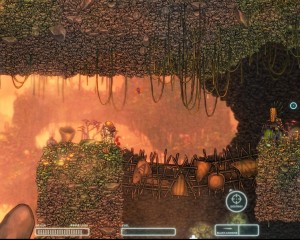Capsized
 Capsized marks a milestone for my hardware’s continuing slide into obsolescence. The monitor I typically game on these days is a projector — a cheap “business” projector with a native resolution of 1024×768. This is more than enough for most of the games I play, but it’s getting to be a stretch for some of the newer ones, which are designed with a higher resolution in mind. (Dungeons of Dredmor, for example, seems to have a fixed pixel size for its various pop-ups, and at 1024×768, they take up more of the screen than they really should. It’s playable, but I wind up opening and closing my inventory a lot, where other players probably just leave it open all the time.) Well, Capsized is the first game I’ve played that doesn’t even support 1024×768. The smallest it’s willing to deal with is 1280×1024. Fortunately, my projector is willing to fake this, with results that look okay from my customary viewing distance.
Capsized marks a milestone for my hardware’s continuing slide into obsolescence. The monitor I typically game on these days is a projector — a cheap “business” projector with a native resolution of 1024×768. This is more than enough for most of the games I play, but it’s getting to be a stretch for some of the newer ones, which are designed with a higher resolution in mind. (Dungeons of Dredmor, for example, seems to have a fixed pixel size for its various pop-ups, and at 1024×768, they take up more of the screen than they really should. It’s playable, but I wind up opening and closing my inventory a lot, where other players probably just leave it open all the time.) Well, Capsized is the first game I’ve played that doesn’t even support 1024×768. The smallest it’s willing to deal with is 1280×1024. Fortunately, my projector is willing to fake this, with results that look okay from my customary viewing distance.
So, what is it doing with all those pixels? Throwing in lots of scribbly detail, mainly. This game has ludicrously over-detailed hand-drawn art. Even the rock walls aren’t simply displayed as solid rock, but as masses of tiny individual rocks without any obvious tiling pattern. It’s a style that I associate with things doodled in notebooks over the course of very long meetings, although of course here it’s animated. And I don’t just mean the foreground: vines sway in the breeze, alien bird-analogues drift about in the distance.
Alien, yes, for this is a game about beleaguered astronauts with worried expressions, crash-landed on a jungle world. So no, there isn’t really any capsizing involved. The title was presumably chosen as a synonym for “shipwrecked”, even though it specifically means “tipped over”, which isn’t really applicable to a spaceship. But I suppose the nautical term helps to establish the metaphor of sailors stranded on a remote island, facing unfamiliar tropical wildlife and hostile natives. And yeah, the inhabitants of this planet are plainly modeled on notions of the primitive savage, with their large masks and blowguns — although, for all that, they’re powerful enough to pose a threat to humans with spacefaring technology and blasters. (Not enough of a threat to actually stop you, of course.)
Now, about those blasters. This is one of those platformers where you move with the keyboard and aim with the mouse, a combination that seems to have become ubiquitous in platformers these days. You have a FPS-like assortment of different weapons, such as a machine gun that fires rapidly but inaccurately, a slow but powerful laser, homing missiles, and so forth. Your basic blaster can be fired infinitely, but the ammo for your other weapons is limited, and can be found scattered through the levels, usually in hard-to-reach places. What’s unusual about this is that you start over with just your basic blaster at the start of each level. So, there’s the hoarding problem solved: every level is completely self-contained. Lives are also reset with each level, as is the status of your jetpack fuel.
The whole business with the Jetpack fuel is interesting. Being able to fly tends to ruin the platforming, so jetpack fuel is found in quantities designed to run out. But what if you use up all the fuel on the level and thereby render bits inaccessible? The game solves this with recharging jetpack fuel, which you can find towards the end of the level. This places the same limit on how far you can fly at a stretch, but regenerates when you’re standing on the ground. This is invaluable for hunting for the level’s last few secrets, because they tend to involve hidden tunnels in those overdetailed rock walls, and the entrance hole can be anywhere, at any elevation.
The thing is, that’s almost all you need the jetpack for. Your astronaut can jump pretty high, and climb vertical surfaces, and comes equipped with a tractor beam. This last is like a combination of Half-Life‘s gravity gun and a grappling hook. That is, you can latch it onto objects to lift, pull, or hurl them, but you can also latch it onto the ceiling above you and swing from the glowing force beam thus created. To the extent that this game contains puzzles, they involve the tractor beam: tricky climbing, rearranging obstacles, transporting boulders to where you need them as weights or stepping-stones. This is also the main way that the game shows off its physics engine.
 Comments(1)
Comments(1)
Wouldn’t “Shipwrecked” have worked as well as a nautical metaphor, while also making sense?
What I really want to say is, the rock at the lower left corner of the screenshot makes it look like your thumb is in front of the camera.